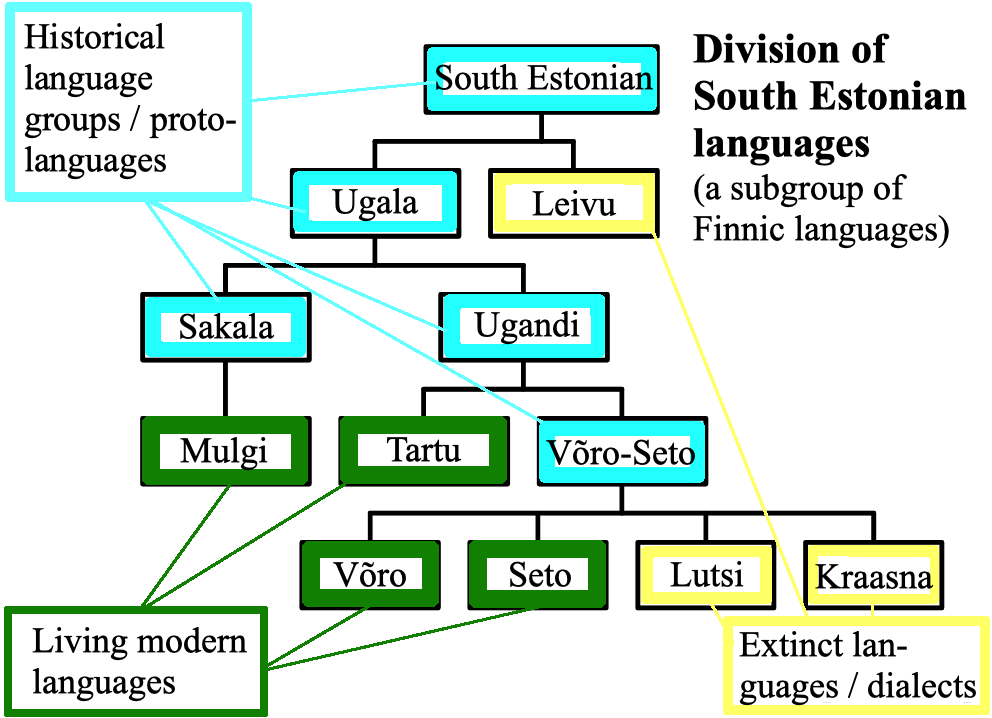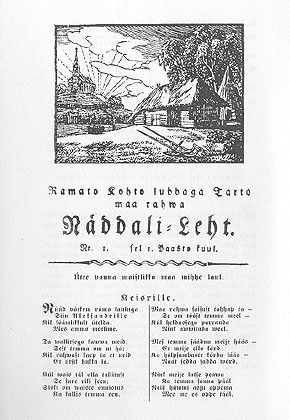|
Centre For South Estonian Language And Cultural Studies
The Centre for South Estonian Language and Cultural Studies is an interdisciplinary unit at the Faculty of Philosophy of Tartu University. The centre coordinates and organizes linguistic and cultural studies in the historical South Estonian (Võro, Seto Seto may refer to: Places * Seto, Aichi, production place of Japanese pottery and venue of Expo 2005 * Seto, Ehime, facing the Seto Inland Sea *Seto, Okayama, adjacent to Okayama, in Okayama Prefecture *Seto Inland Sea of Japan * Setomaa (''Seto ..., Mulgi and Tartu) area. The centre also publishes books and organizes events connected with South Estonian language and culture. External links Home page of the centre in Võro and Estonian South Estonian language Estonian culture Education in Tartu {{Estonia-stub ... [...More Info...] [...Related Items...] OR: [Wikipedia] [Google] [Baidu] |
Tartu University
The University of Tartu (UT; et, Tartu Ülikool; la, Universitas Tartuensis) is a university in the city of Tartu in Estonia. It is the national university of Estonia. It is the only classical university in the country, and also its biggest and most prestigious university. It was founded under the name of ''Academia Gustaviana'' in 1632 by Baron Johan Skytte, the Governor-General (1629–1634) of Swedish Livonia, Ingria, and Karelia, with the required ratification provided by his long-time friend and former student – from age 7 –, King Gustavus Adolphus, shortly before the king's death on 6 November in the Battle of Lützen (1632), during the Thirty Years' War (1618–1648). Nearly 14,000 students are at the university, of whom over 1,300 are foreign students. The language of instruction in most curricula is Estonian, some more notable exceptions are taught in English, such as semiotics, applied measurement science, computer science, information technology law, and Europe ... [...More Info...] [...Related Items...] OR: [Wikipedia] [Google] [Baidu] |
South Estonian Language
South Estonian, spoken in south-eastern Estonia, encompasses the Tartu, Mulgi, Võro and Seto varieties. There is no academic consensus on its status, as some linguists consider South Estonian a dialect group of Estonian whereas other linguists consider South Estonian an independent Finnic language. Diachronically speaking, North and South Estonian are separate branches of the Finnic languages. Note that reconstructed *č and *c stand for affricates , . Modern Standard Estonian has evolved on the basis of the dialects of Northern Estonia. However, from the 17th to the 19th centuries in Southern Estonia, literature was published in a standardized form of Southern Tartu and Northern Võro. That usage was called Tartu or literary South Estonian. The written standard was used in the schools, churches and courts of the Võro and Tartu linguistic area but not in the Seto and Mulgi areas. After Estonia gained independence in 1918, the standardized Estonian language policies were ... [...More Info...] [...Related Items...] OR: [Wikipedia] [Google] [Baidu] |
Võro Language
Võro ( vro, võro kiilʼ, link=no , et, võru keel) is a language belonging to the Finnic branch of the Uralic languages. Traditionally, it has been considered a dialect of the South Estonian dialect group of the Estonian language, but nowadays it has its own literary standard and efforts have been undertaken to seek official recognition as an indigenous regional language of Estonia. Võro has roughly 75,000 speakers ( Võros) mostly in southeastern Estonia, in the eight parishes of the historical Võru County: Karula, Harglõ, Urvastõ, Rõugõ, Kanepi, Põlva, Räpinä and Vahtsõliina. These parishes are currently centred (due to redistricting) in Võru and Põlva counties, with parts extending into Valga and Tartu counties. Speakers can also be found in the cities of Tallinn and Tartu and the rest of Estonia. History Võro is a descendant of the old South Estonian regional language and is the least influenced by Standard Estonian (which is based on Northe ... [...More Info...] [...Related Items...] OR: [Wikipedia] [Google] [Baidu] |
Seto Language
Seto (; et, setu keel) is a dialect of Estonian or a separate language spoken by 12,549 people. It is sometimes identified as a dialect of Võro, or the two are described as one language, Võro-Seto. Setos () mostly inhabit the area near Estonia's southeastern border with Russia in Setomaa, and are primarily Eastern Orthodox, while Võros () are traditionally Lutherans and live in historical Võru County. Language sample Article 1 of the Universal Declaration of Human Rights: * Seto: * Võro: * Estonian: * Finnish: * English English usually refers to: * English language * English people English may also refer to: Peoples, culture, and language * ''English'', an adjective for something of, from, or related to England ** English national ide ...: ''All human beings are born free and equal in dignity and rights. They are endowed with reason and conscience and should act towards one another in a spirit of brotherhood.'' References ... [...More Info...] [...Related Items...] OR: [Wikipedia] [Google] [Baidu] |
Tartu Language
South Estonian, spoken in south-eastern Estonia, encompasses the Tartu, Mulgi, Võro and Seto varieties. There is no academic consensus on its status, as some linguists consider South Estonian a dialect group of Estonian whereas other linguists consider South Estonian an independent Finnic language. Diachronically speaking, North and South Estonian are separate branches of the Finnic languages. Note that reconstructed *č and *c stand for affricates , . Modern Standard Estonian has evolved on the basis of the dialects of Northern Estonia. However, from the 17th to the 19th centuries in Southern Estonia, literature was published in a standardized form of Southern Tartu and Northern Võro. That usage was called Tartu or literary South Estonian. The written standard was used in the schools, churches and courts of the Võro and Tartu linguistic area but not in the Seto and Mulgi areas. After Estonia gained independence in 1918, the standardized Estonian language policies were i ... [...More Info...] [...Related Items...] OR: [Wikipedia] [Google] [Baidu] |
Estonian Culture
The culture of Estonia combines an indigenous heritage, represented by the country's Finnic national language Estonian, with Nordic and German cultural aspects. The culture of Estonia is considered to be significantly influenced by that of the Germanic-speaking world. Due to its history and geography, Estonia's culture has also been influenced by the traditions of other Finnic peoples in the adjacent areas, also the Baltic Germans, Balts, and Slavs, as well as by cultural developments in the former dominant powers, Sweden, Denmark and Russia. Traditionally, Estonia has been seen as an area of rivalry between western and eastern Europe on many levels. An example of this geopolitical legacy is an exceptional combination of multiple nationally recognized Christian traditions: Western Christianity (the Catholic Church and the Estonian Evangelical Lutheran Church) and Eastern Christianity (the Orthodox Church (the Estonian Apostolic Orthodox Church)). The symbolism of the border ... [...More Info...] [...Related Items...] OR: [Wikipedia] [Google] [Baidu] |



